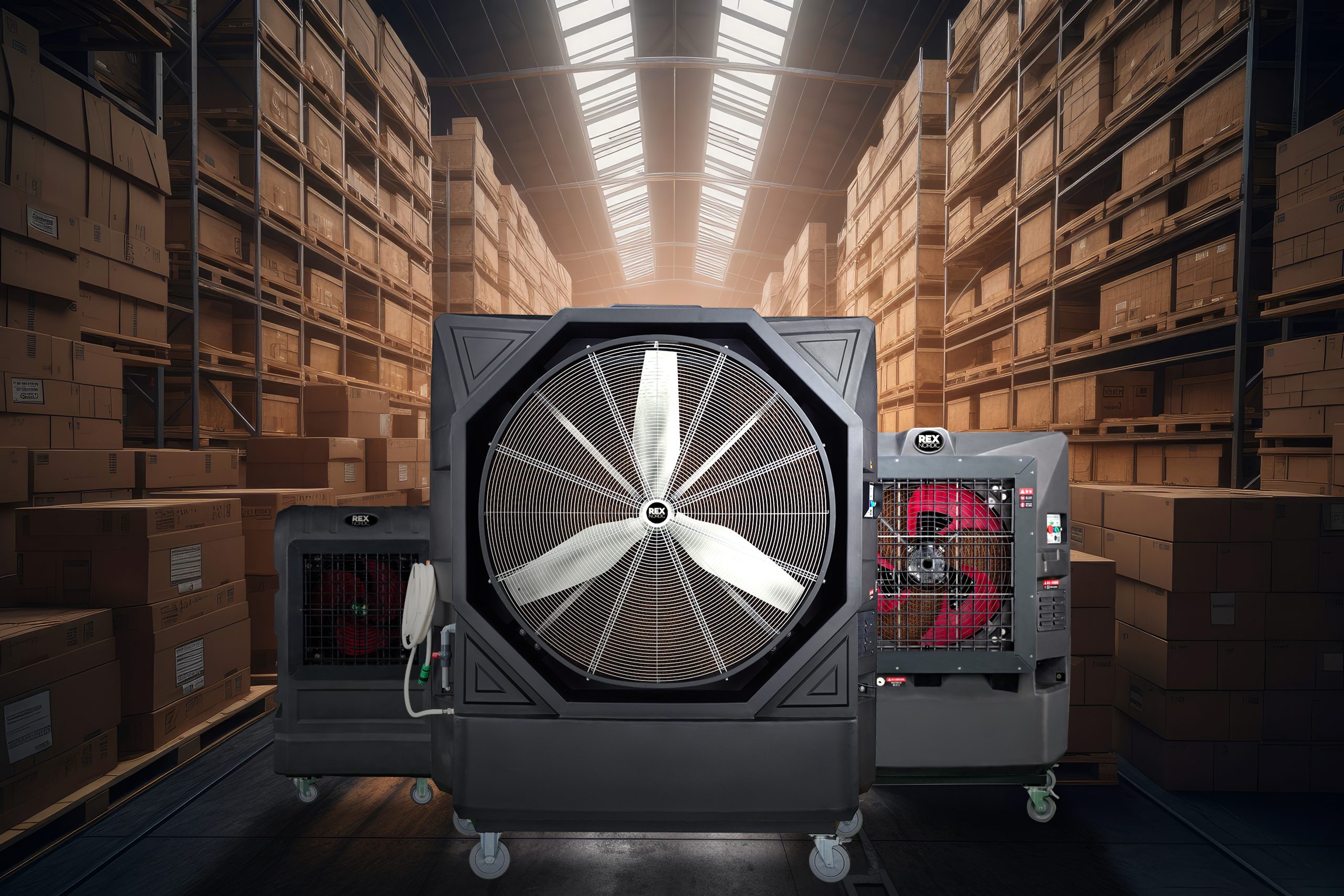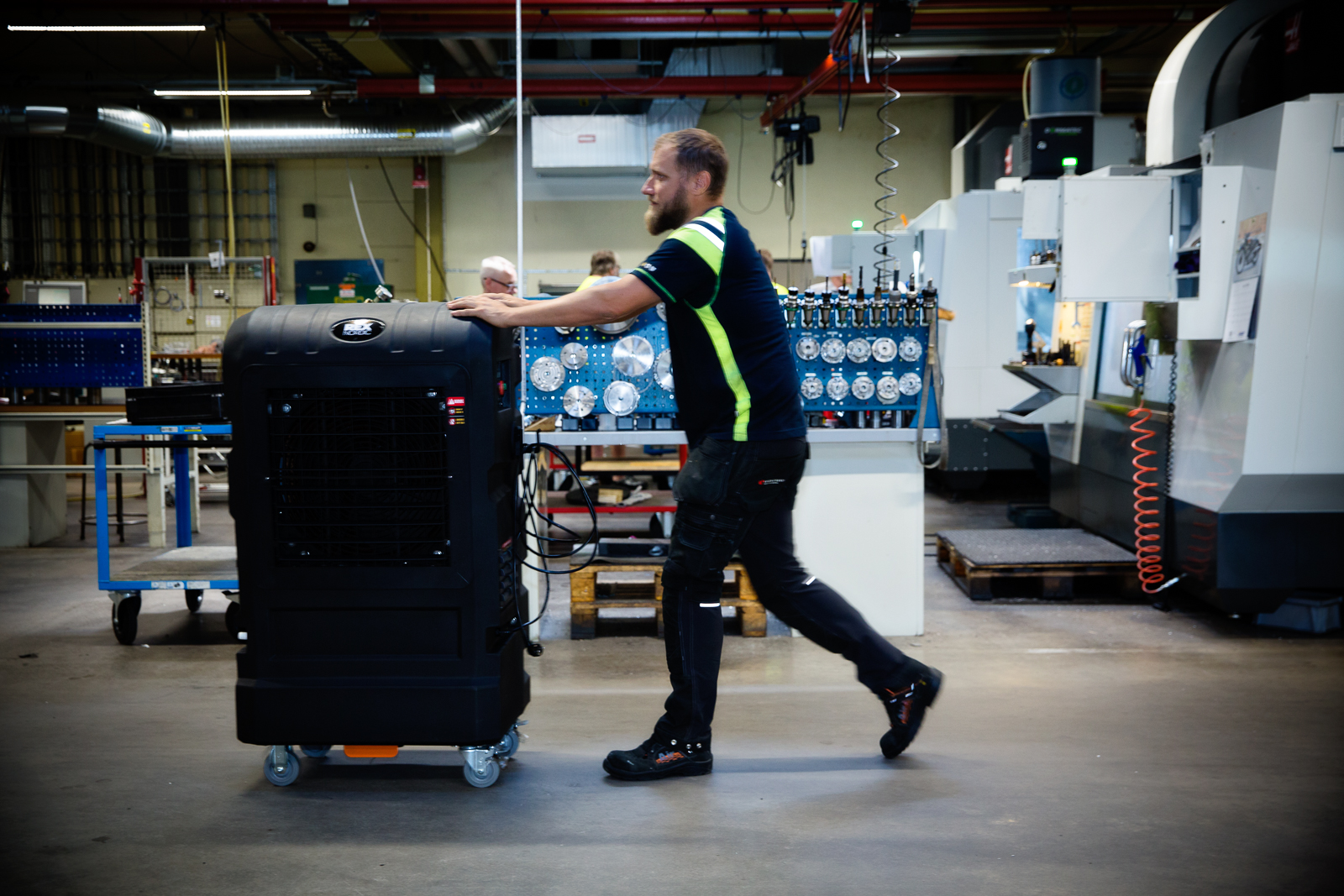
Evaporative coolers are an essential part of modern cooling technology, especially in industrial and other large-space cooling applications. Their advantages include energy efficiency and environmental friendliness compared to traditional air conditioning systems. This article examines the operating principle, applications, and benefits of evaporative coolers, as well as the technical aspects to consider when using them.
Operating Principle of Evaporative Coolers
Evaporative coolers utilize the evaporation process of water to cool the air effectively. This is based on a physical phenomenon where water evaporates and absorbs heat energy from the surrounding air, leading to a decrease in air temperature.
Humidification and Heat Transfer
Water evaporates when exposed to an airstream, and this process absorbs heat from the air, cooling it down. Coolers use special pads designed to maximize the surface area for water evaporation. These pads are often made of cellulose or plastic, which are hygroscopic and provide a large evaporative surface.
Air flows through the pads via a fan, where it encounters water. The water evaporates, absorbing heat energy from the air, thus cooling it.
Energy Consumption and Efficiency
The energy consumption of evaporative coolers is significantly lower compared to traditional mechanical cooling systems because the process uses natural water evaporation and does not require substantial amounts of electrical energy.
The efficiency of these systems depends on the ambient temperature and humidity. They work best in dry and hot conditions where the air’s moisture content is low, as this makes water evaporation most efficient.
Operational Principle
- Adiabatic Cooling: Air is cooled through an adiabatic process where its temperature drops as it becomes humidified. This means that the air’s thermal energy is used for water evaporation without an external energy source.
- Ventilation and Pressure: In the cooler, air passes through the pads via a fan. The air flowing through the pads encounters moisture that evaporates and cools the air. The fan’s role is critical as it ensures sufficient airflow through the pads and guarantees uniform cooling.
- Water Circulation: In evaporative coolers, water circulates continuously. Water is pumped to the top of the pads, from where it flows down and evaporates due to the airstream. The recirculation system ensures even water distribution and optimizes the cooling process.
Applications in Professional Use
Evaporative coolers are widely used across various industries and other large-space cooling applications where efficient and cost-effective cooling is needed.
Industrial Facilities
- Metal Industry: In hot factory halls where temperatures can rise extremely high, evaporative coolers provide an efficient cooling solution that helps keep the working environment tolerable and safe.
- Automotive Industry: Assembly lines and paint shops in car factories benefit from a cooler working environment, which improves worker efficiency and reduces errors.
- Food Industry: Evaporative coolers are ideal for cooling large storage and production areas where temperature control is critical to maintaining product quality.
Data Centers
Data centers require continuous and efficient cooling to prevent equipment from overheating. Evaporative coolers offer an energy-efficient alternative that can significantly reduce cooling costs in data centers.
Using adiabatic cooling, data centers can also reduce their carbon footprint, which is increasingly important as environmental regulations tighten.
Agriculture
- Greenhouses: Evaporative coolers help maintain optimal growing conditions, improving crop yields and growth rates. Cooler air reduces plant stress and enhances their resistance to diseases.
- Animal Shelters: Animal welfare improves in cooler conditions, leading to better health and productivity. This is especially important during the summer months when heat stress can negatively affect animal well-being.
Advantages and Challenges
Evaporative coolers offer many advantages.
Advantages
- Energy Efficiency: Evaporative coolers use significantly less electrical energy compared to traditional cooling systems because they rely on the natural evaporation process.
- Environmental Friendliness: Since the system only uses water and air for cooling, its environmental impact is minimal, and the carbon footprint is small. This makes them an attractive option for organizations aiming to reduce their environmental impact.
- Cost Savings: Lower energy consumption and simple technology mean lower operating and maintenance costs compared to complex mechanical cooling systems.
Technical Considerations and Design
Portable evaporative coolers are highly convenient and flexible solutions for various professional cooling needs. Their technical design and use require special attention to the following aspects:
Components and Materials
- Pads: The pads are the central part of the cooler responsible for water evaporation. They are often made of cellulose or plastic, providing a large evaporative surface and withstanding moisture and mechanical wear.
- Fans: Powerful fans ensure sufficient airflow through the pads. The performance of the fans directly affects the efficiency of the cooler.
- Water Systems: Water systems pump water to the top of the pads, from where it flows down and evaporates due to the airstream. The systems include filters and pumps that ensure water circulation and cleanliness.
Device Placement
- Airflow Control: Optimal airflow and ventilation are essential to maximize cooling. Portable coolers should be placed to draw in as much dry and hot air as possible for the most effective evaporation.
- Water Source and Quality: A clean and adequate water source is vital for the system’s operation and longevity. Water quality affects the durability and efficiency of the pads and water systems.
Considering Portability
- Durable Construction: Portable evaporative coolers must be durable and sturdy enough to be easily moved to different locations. This means strong frame materials and well-protected components.
- Practical Wheels: Large wheels enable easy movement of the device and are designed to withstand various floor materials and surfaces.
- Easy Connectivity: Coolers are easy to connect to electrical and water sources in different locations. They have practical connections and sufficiently long cables and hoses.
Impact of UV Light
UV light is used in evaporative coolers to improve water quality and prevent bacterial growth.
- Water Disinfection: UV light kills microorganisms and bacteria in the water, reducing biofilm and slime formation on the pads. This improves the system’s hygiene and reduces maintenance needs.
- Pad Cleanliness: UV light helps keep the pads free from biological impurities, enhancing their evaporative efficiency and extending their lifespan.
- Cost Savings: Using UV light reduces the need for chemical cleaning agents and improves the system’s overall efficiency, leading to significant savings in maintenance costs.
Technical Features
Portable evaporative coolers have several technical features that enhance their usability and efficiency:
- Stepless Adjustable Fan: Portable coolers often have a stepless adjustable fan that allows precise airflow control. This feature is useful for optimizing cooling in different conditions and spaces.
- Fan-Only Mode: The cooler can also be used as a fan only, with the water pump turned off. This feature is convenient when only air circulation is needed without cooling, such as on cooler days or in conditions where active cooling is not required.
- Automatically and Manually Operated Air Deflectors: Coolers have air deflectors that can operate both automatically and manually. Automatically operated air deflectors adjust the direction of the airflow optimally to enhance cooling. Manually adjustable air deflectors allow the user to customize the direction of the airflow and focus cooling exactly where needed.
- Automatic and Manual Water Filling: Coolers have an automatic water filling system that can be connected directly to a water hose. This ensures a continuous and consistent water supply without the user having to worry about filling the water. If no water point is nearby, water can be added manually, increasing the device’s flexibility and usability in different conditions.
These technical features make portable evaporative coolers versatile and user-friendly solutions suitable for various professional cooling needs. Evaporative coolers offer cost-effective and environmentally friendly cooling solutions for professional use.

